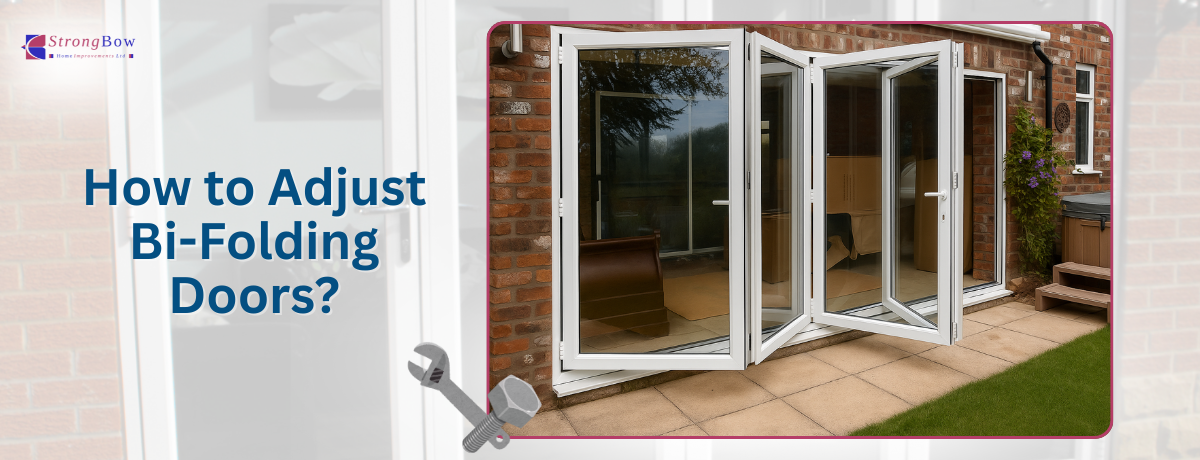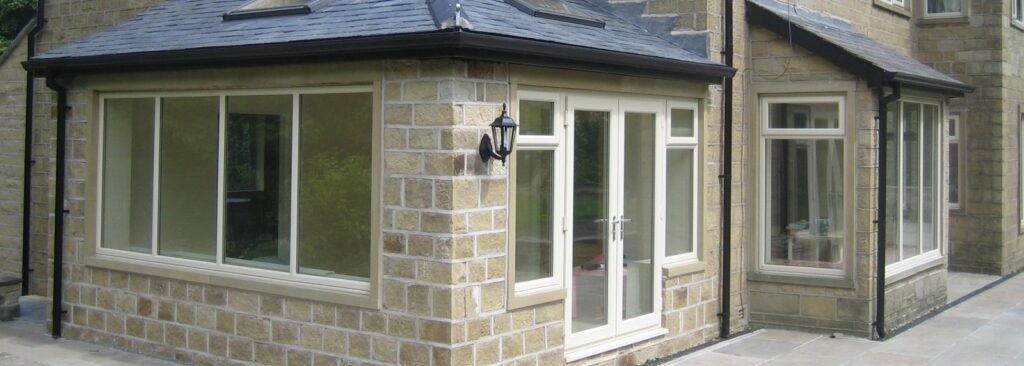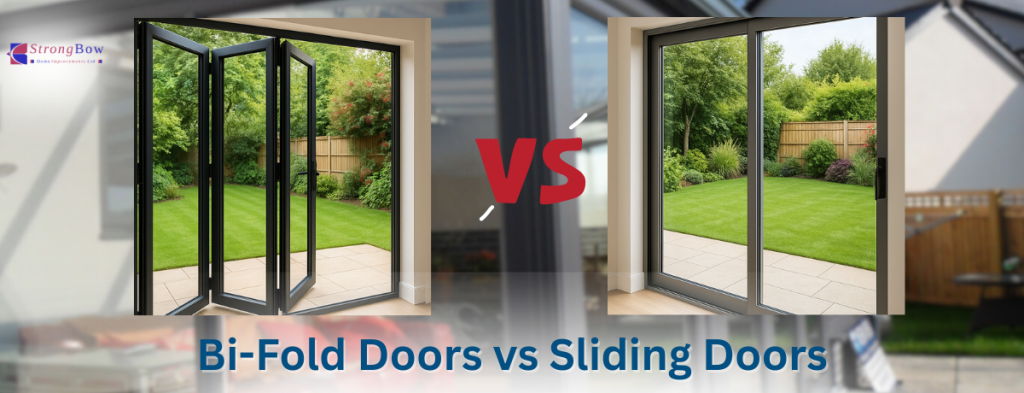(Step-by-Step Guide for DIY Homeowners)
Bi-fold doors make a home feel open, bright, and modern, but over time, they can stop running as smoothly as they should.
You might notice the panels dragging, catching on the track, or not closing properly. That usually isn’t a fault in the door itself. More often, it’s a small movement in the frame or the bifold door hinges easing slightly out of line.
These doors are built to fit perfectly within their frame. That’s why, even a small shift, let’s say a few millimetres, can stop them sliding as they should. If the handle feels tight or the panels scrape along the bottom, you only need to do a small adjustment to get them to move freely again.
Having years of experience installing, manufacturing, and supplying bi-fold doors across the UK, we easily understand a well-fitted door can start to drift out of line.
That’s why, in this blog, we’ll talk about how you can spot the problem and make adjustments step by step in your bi fold doors. After this, surely they’ll run straight, seal properly, and keep their easy glide.
Let’s get started!
Step 1: Check What’s Causing the Problem
Before you reach for the tools, take a moment to watch how the doors move. Most problems become clear once you open and close them a few times.
- Dragging panels usually point to a height or pivot issue.
- Uneven gaps often mean the frame’s slightly out or the glass needs toe-and-heeling.
- Hard to close or lock suggests a compression or alignment problem.
- Panels popping open or dropping are signs of loose or worn hinges.
When adjusting bifold doors, always clean the tracks first. Grit and debris can make doors stick, and many “faults” disappear after a simple bifold door adjustment and a bit of track maintenance.
Step 2: Collect Equipment for Bi Fold Door Adjustment
Before starting, make sure you’ve got the basics ready. Having everything on hand will make how to adjust bi fold doors much quicker and easier.
| Tool / Item | Purpose / Notes |
| 4mm–5mm Allen key | For height and hinge adjustments |
| Phillips or flathead screwdriver | Tightening or loosening screws and brackets |
| Adjustable wrench | Handy for hinge bolts and pivot pins |
| Tape measure & spirit level | To check alignment and even gaps |
| Soft cloth | For wiping hinges and tracks clean |
| Silicone-based spray | Keeps rollers moving smoothly (avoid oil-based lubricants) |
| Stepladder, pliers, or packers (optional) | Useful for fine-tuning, toe & heeling, or reaching top pivots |
If you have the right tools from the start, you’ll save time and avoid forcing the parts that you don’t actually need. After collecting everythign from the list, you are ready to move to the next step i.e. checking and cleaning the door tracks.
Step 3: Clean and Prep the Door Tracks
Anyone asking “how do you adjust bifold doors properly” should start with one simple task, i.e. cleaning the tracks. Don’t skip this step, sometimes, its the dust and grit that’s causing the very problems you are trying to fix with adjustments.
Open the doors fully and clear both top and bottom tracks using a small brush or vacuum nozzle. Wipe with warm, soapy water and let them dry completely. Check the rollers, hinges, and pivots for buildup or rust , as debris caught here can even affect bifold door height. Finish with a light coat of silicone spray to keep the doors sliding freely.
Step 4: Adjust Door Height (Vertical Adjustment)
If your doors drag on the track or sit unevenly, it’s time for a height adjustment. This step is important because even a few millimetres out of line can stop the doors from sealing or sliding properly. Whether your setup is timber, aluminium, or uPVC, the process works the same way.
Start by locating the bottom hinge bolt or pivot pin; this is usually found at the corner of the lead door. Insert a 4mm or 5mm Allen key into the adjustment slot and turn clockwise to raise the door or counter-clockwise to lower it. Adjust both outer hinges equally so the lift remains consistent.
After each turn, open and close the doors to check clearance. Aim for even gaps of around 4–6 mm between the frame and panels, just as you’d ensure during a proper folding door installation. For top-hung systems, use the top carriage screw and make small, equal turns on both sides to keep everything balanced.
Step 5: Correct The Side-to-Side Alignment
Are your bi-fold doors scraping the frame? Are the panels not lining up properly?
In both the cases, they’ve probably shifted a bit to one side. This is a common issue that you’ll see after fitting bifold doors. Sometimes, the frame moves a little when the temperature changes.
Here’s how to get them straight again:
- Open the doors all the way so you can reach the small metal brackets at the top and bottom.
- Use a screwdriver to loosen the screw on the bracket slightly — just enough to move it.
- Gently slide the bracket left or right until the panels look even and the gaps between them are the same.
- Tighten the screw back up once the doors look straight.
- Step back and check: the gaps along the top and sides should look even, and the doors should close smoothly without rubbing.
- If the lock still feels stiff, turn the small pivot screws at the top and bottom a half-turn at a time until it closes easily.
Once you’ve done this, you’ll have a good idea of how to adjust bi fold folding doors properly, that is, the small, careful turns are all it takes to get a smooth and balanced finish.
Step 6: Adjust Lock Compression (for Hard-to-Lock Doors)
When your doors won’t lock smoothly, the issue is often compression and not alignment. In other words, the doors are either pressing too tightly against the seal or not tight enough to close properly.
Here’s how to fix it:
| What to Check or Do | How to Do It | Why It Matters |
| 1. Find the adjuster pin | Look for a small metal pin near the lock mechanism or jamb profile on the main door. | This pin controls how tightly the door seals when locked. |
| 2. Insert your Allen key | Place the Allen key in the pin and turn it slowly. | Helps you fine-tune compression safely without damaging parts. |
| 3. Adjust the pressure | Turn inward to make the seal tighter, or outward to loosen it. | You’re balancing pressure so the lock engages easily but still seals properly. |
| 4. Test and repeat | Close the door and test the handle after each small turn. | Small changes are best — forcing it can make the bifold door catching at bottom worse. |
| 5. Final clearance check | Most recommended bi fold doors need roughly 16 mm of clearance between the lock and receiver plate. | Ensures smooth locking and a proper weather-tight seal. |
How to adjust folding doors correctly? Always make minor turns and check the door after each one. Over-tightening can make the handle feel stiff, while loosening too much can let in draughts.
Step 7: Check Toe-and-Heeling (for Sagging Panels)
If your bi-fold doors keep dropping even after adjusting them, the problem could be with the balance of the glass inside each panel.
This is where toe-and-heeling comes in, which is a method that repositions the glass diagonally so its weight supports the frame rather than pulling it down. It’s particularly important for heavier or wider panels, especially those built with strong bi fold door hinges types.
For this, start by removing the glazing bead carefully to access the glass. Insert small plastic packers in the bottom corner on the hinge side and the opposite top corner of the same panel. Repeat this in a zigzag pattern across wider sets to spread the weight evenly.
Once done, refit the beads and test the doors. Now they should move freely without sagging. If the problem continues, consider calling a specialist in bi fold door repairs London to have the glazing re-packed professionally.
Step 8: The Finishing Touch — Tighten and Test
Lastly, you have to check if everything is secure and moving smoothly.
If there is any loose screw on the bifold hinges or brackets, the doors may rattle or sit unevenly, that’s why, tighen anything that looks loose. Also, you can place a small piece of wood inside before refitting a screw if it feels worn. With this trick, it will help it hold firmly.
Next, apply a silicone spray to the rollers, pivots, and tracks. Avoid oil-based products, as they attract dust and make the doors harder to move over time. Wipe away any excess and open and close the doors a few times to spread the lubricant evenly.
Whether you’re maintaining existing doors or learning how to fit bi folding doors, with this step, you’ve ensured your doors fold smoothly, close properly, and stay in good working order.
Worth having a look: Bi-Fold Doors vs Sliding Doors: Which Is Best for Your Home?
When Do You Replace Your Doors?
If your bi-fold doors still don’t open or close properly after adjustment, it might be more than a quick fix. Bent tracks, damaged pivots, or sagging frames can all stop even the best bifold doors from running smoothly.
You may need to repair or replace your doors if you notice:
- The doors sag again shortly after adjustment.
- The panels keep catching the track or frame.
- Hinges or pivots are cracked, loose, or beyond repair.
- Locks or handles stay stiff even after lubrication.
For small issues, removing the affected panel, cleaning the track, and replacing a worn hinge or bottom pin often restore smooth movement. But if the problem keeps coming back, it’s worth upgrading to a newer system that performs better and lasts longer.
Strong Bow Home Improvements are UK suppliers, manufacturers, and installers of high-quality bi-folding and composite doors, Manufactured in Great Britain. Contact us today for expert advice, professional fitting, or a full replacement; we’ll make sure your doors are installed perfectly and built to last.



